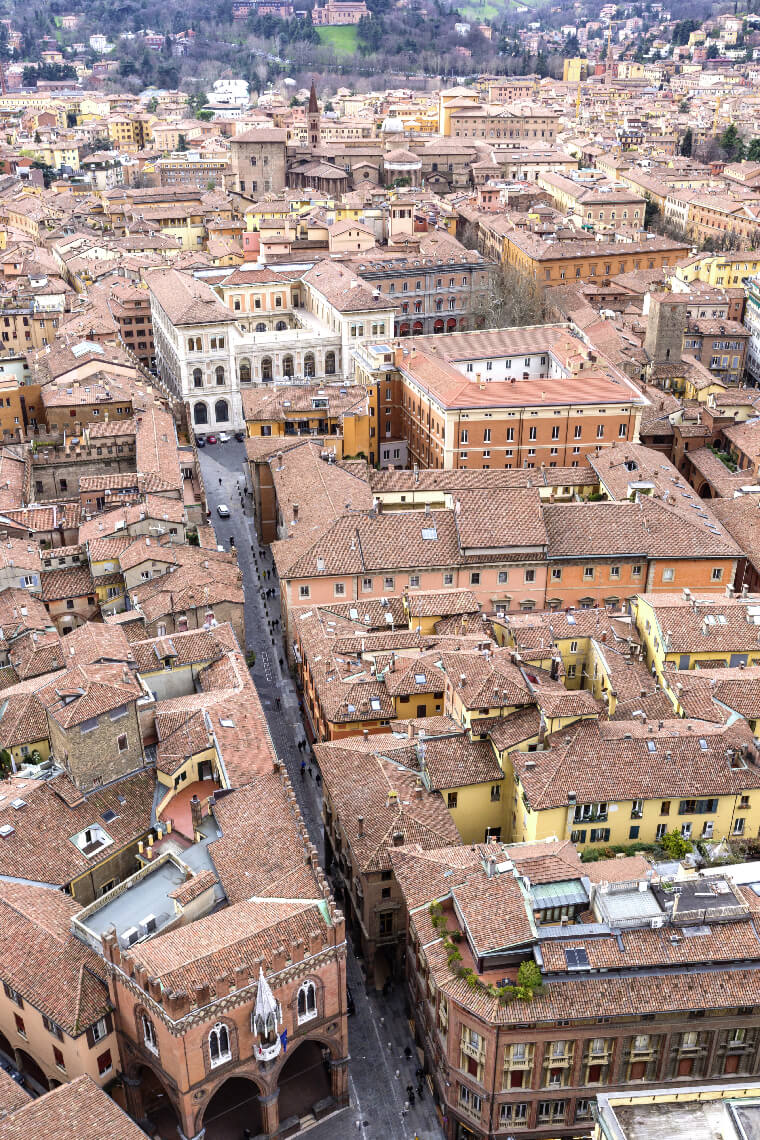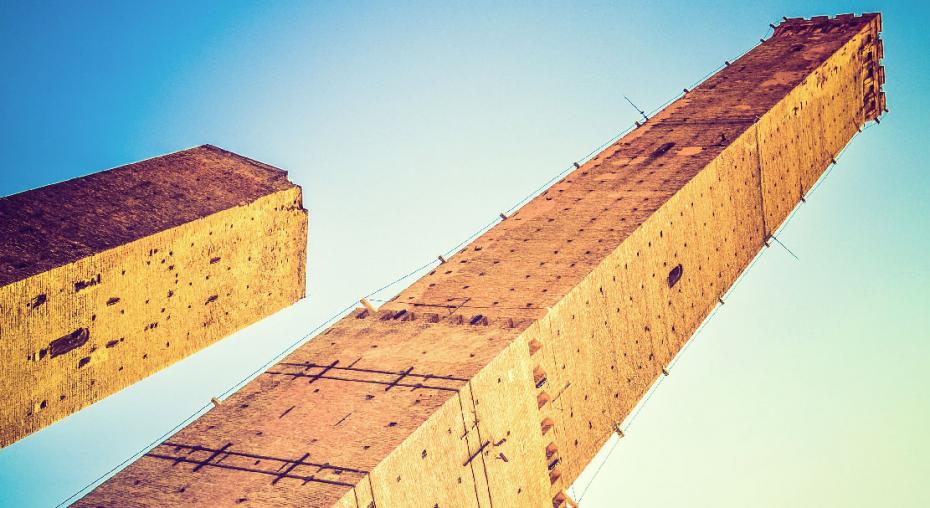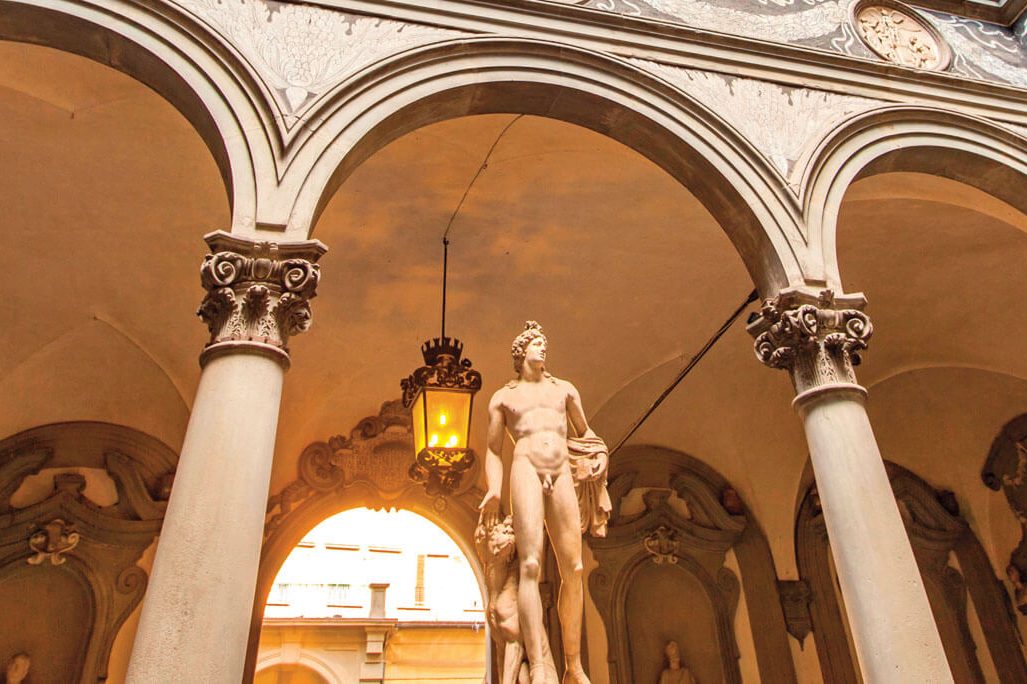Everybody knows about the leaning tower in Pisa, but how many people have ever noticed that Bologna has two of them and that they are even older? In fact, it appears that the buildings affectionately known by the Lord-of-the-Ringsesque name of “Two Towers” have a lot to offer: one of them, the Torre degli Asinelli, is much taller than the Pisan one, while the other, called Garisenda, leans a little more. Let’s climb both of them together.
Built roughly between the years 1109 and 1119 by the noble families that still give them their respective names, the Two Towers have since become one of the city’s most prominent landmarks. Sure enough, they give us the best possible view on a time when Bologna was at the zenith of its power and was called “la turrita”, that is “the city with many towers”: as a matter of fact, during the Middle Ages hundreds of similar towers were erected within the city walls, both for military purposes and to let each family assert its own power before all the others, as it was the case in the Tuscan town of San Gimignano.
Today, as much as twenty four of that sky-reaching buildings still exist in Bologna, but probably none of them is as eye-catching as the entwined complex of the Two Towers. By standing at their very feet, just in front of a 17th century statue of the local patron saint, St. Petronius, at first one cannot but look up to the sky and see the dizzy effect created by the intersection of Garisenda’s incline and Asinelli’s height. Then, each visitor would probably decide to walk around them gently, still looking upwards to their tops and trying to discern the uniqueness in the symbiosis of the two, while also noticing a little hidden treasure on one of the slopes of the Garisenda: an inscription from Dante’s Divine Comedy mentioning that very tower.

As we may learn from a source as distinguished as the 31st canto of the Inferno, by Dante’s times the tower had probably already sunk into the ground because of its foundation problems. At about 4.0°, the current incline of the Garisenda slightly outreaches that of the Pisa Tower, even though some recent studies have found that the slope continues to grow by at least a millimeter for every passing year. What has surely changed since the Sommo Poeta honored this tower in his masterpiece – but also in an earlier, lesser-known sonnet now collected in his Rhymes – is the overall height of the Garisenda, which was formerly sixty meters tall, but had to be cut down to forty eight around 1350 to prevent it from falling. Unfortunately, the interior of the tower is no more available for visits due to similar security reasons.
As for the nearing Torre degli Asinelli, once connected to the Garisenda by some wooden passageways, scholars have suggested that it might have had just about the same height to begin with, but while the other building was chopped, this in turn was soon raised to its current ninety seven meters, making it the tallest leaning tower in Italy: by comparison, even the one in Pisa is forty meters shorter! Yet the fact remains that a sort of strange optical illusion seems to occur as you stare at the Two Towers from the bottom up: given the Asinelli’s slight incline (only 1.3°) and its contrast with the Garisenda, for something like a second one doesn’t even notice that the former actually leans, too.
All in all, the view from below is already spectacular… but not nearly as breath-taking as the one you can enjoy from above: nestled in the porticoes at the very base of the Asinelli Tower, surrounded by the old stores that were once the core of Bologna’s Central Market, one finds the door to the top. Beware all ye who enter, though, if you are afraid of heights: you’d have to climb a wooden winding stairway that gets narrower and steeper as you go up. But in the end, with as much as five hundred shaky steps left behind, this somehow creepy experience should finally reveal its benefits.
By fighting your way to the top of the tower, you’d find yourself on the rampart that in medieval times, at least for a while, served as a prison, while being used as a real watchtower during World War II, when its survival was seriously threatened by air raids. But most importantly, you’d happen to be rewarded with the wonders of a belvedere that is beyond any price: right under your feet the tiny Garisenda with its leaning profile, just a little ahead the Piazza Maggiore with its unfinished Basilica, and out there in the distance the hills on which the Sanctuary of San Luca stands. A view that Goethe himself described as “splendid”!





























